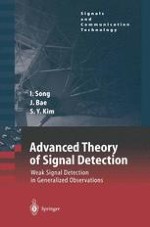We have some time ago noticed that finding a book dealing with topics in the ad vanced theory and applications of signal detection is not quite an easy matter. This is contrasted with that there are numerous books on the more general subject of de tection and estimation.Frankly, ourexperience and expertise is only on some partial portions of the theory and recent topics of signal detection. This book is therefore meant to include not all the advanced and interesting topics in the theory and appli cations ofsignal detection, butjust onlysome subsets of them: some such important and interesting topics and issues as distributed signal detection and sequential de tection are not considered only due to our limited knowledge and capacity. The goal we have in mind for this book is to present several advanced topics in signal detection theory and thereby help readers gain novel ideas and insights. In this book, we have tried to completely present in a unified way the theme oflocally optimum detection ofsignals in generalized observations. Among our hope is thus that the readers would be able to understand the concepts and fundamentals of a generalized observation model as applied to signal detection problems. This book will also allow the readers, whether they are students, academics, practitioners, or researchers, to have an expanded view on signal detection.
